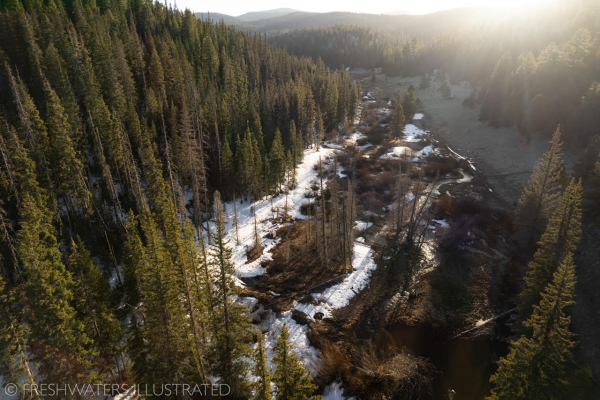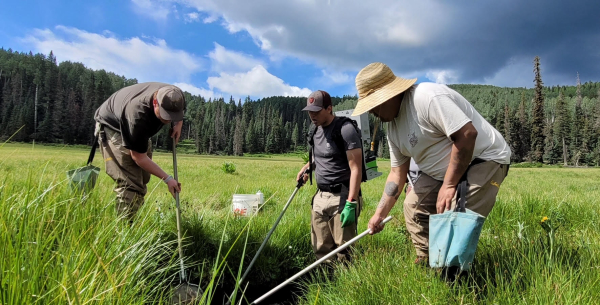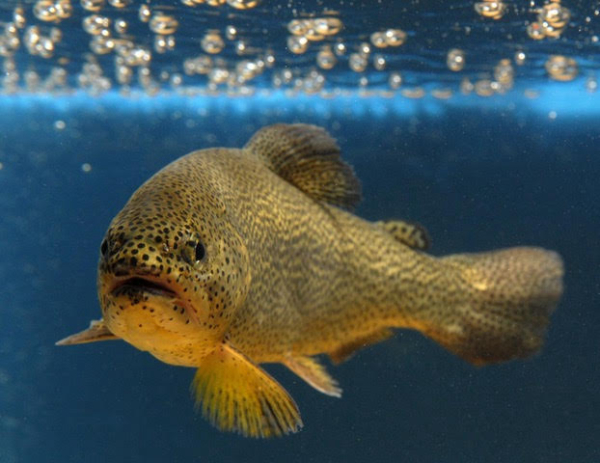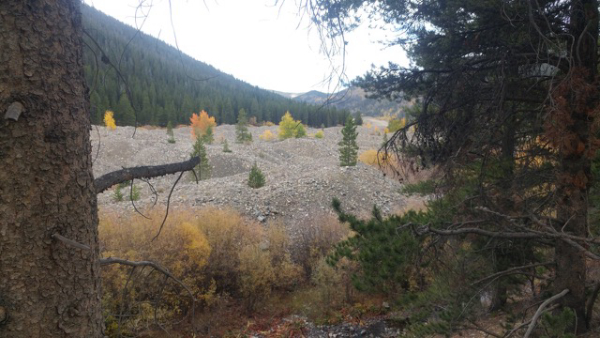Casting to a Fly Rod to Apache Trout is a Testament to Perseverance
I’m standing knee deep in the cold crystalline waters of a narrowgravelly stream in the highest headwaters of the White Mountains of southeast Arizona. Apache trout live here.

A spindly 2-weight fly rod and a barbless hook ornamented with fur and feather are the ligaments to the object of my affections. Fresh lime-green fronds of streamside grasses arc over the water pooled behind a downed ponderosa, its cooling shade make a lair for the pretty trout. A short cast lands an Elk-hair Caddis along a seam of flow. The fly wafts downstream toward trout who face upstream waiting for the groceries to come to them. A darting flash and a splash and the trout is transmogrified in the tug I feel in my forearm through the bent rod.
It’s exhilarating. An eight-inch lemony-yellow Apache troutpeppered with haloed black spots lying in my net is really something to witness. It’s a trophy, but not for its size. Catching an Apache trout on a fly rod is a testament to the diligence of a good many people who cared about this rare trout over the span of decades. If not for their conservation work, this experience would not be possible.
?????____________
On August 10, the U.S. Fish and Wildlife Service announced a proposal to delist the Apache trout at an event with the White Mountain Apache Tribe, the U.S. Forest Service, the Arizona Game and Fish Department and Trout Unlimited at Williams Creek National Fish Hatchery. The Apache trout stands to be the first sport fish species to be recovered and removed from the federal list of threatened and endangered species.
And what a path it has wended to get here. The Apache trout went from anonymity to misidentification to an endangered species, and the official state fish of Arizona over the span of a century.

While the Apache people traditionally eschewed the trout as a food source for cultural reasons, the fish had been familiar to anglers for quite some time. Local Hispanic and Anglo farmers and ranchers made forays into the high country in summer to catch them. One correspondent, simply “J.H.” from Show Low, Arizona, wrote in a July 1886 issue of the St. John’s Herald: “I speak truly when I say it was the most enjoyable period of my life.” He recounted how he and his pals caught scads of Apache trout from the White River during a prolonged and enviable summer outing.
The Apache trout had become known to science only a few years earlier in 1873, when it was collected by members of the U.S. Geographical Survey, though it was wrongly identified as a Colorado River cutthroat trout. The fish naturally occurred only in the high-elevation streams that vein off the White Mountains, like fingers palming a softball, all flowing eventually to the Pacific Ocean if not soaked up by sun and sand beforehand.
Renowned conservationist, Aldo Leopold, started his forestry career in Apache National Forest, and wrote to his father back in Iowa in 1909, inviting him to come catch the “very succulent trout” that abounded in White Mountains.
It wasn’t until 1972 that the trout was properly recognized as a unique species and assigned its current common name. A year later—50 years ago—it was placed on the Endangered Species List, by then reduced to a mere 30 miles of streams all within the confines of the Fort Apache Indian Reservation.
The Apache trout is named for the people and the place that are intertwined with one another. The White Mountain Apache Tribe were the first conservators of their namesake fish, having closed off streams to angling on the Fort Apache Indian Reservation in 1955.
Their prescient act set the stage for a comeback.
Places everywhere have their scars, and the White Mountains are no exception, both on the Apache-Sitgreaves National Forest and Fort Apache Indian Reservation. The loss of habitat from excessive timbering and grazing and the introduction of non-native trout species proved detrimental to the native Apache trout. Over-stocked cattle trampled stream banks and reduced shrubs that would cool trout waters in their shade. Accelerated topsoil erosion during the spring run-off affected trout reproduction; fine sediments clogged porous gravel beds where oxygen-rich water would otherwise percolate over incubating Apache trout eggs. Wildfires have taken a toll.
Over the last 70 years, through the actions of the White Mountain Apache Tribe, followed by work with the U.S. Fish and Wildlife Service, U.S. Forest Service, Arizona Game and Fish Department, and the assistance of Trout Unlimited, Apache trout populations have rallied through habitat restoration, brood stock development, and stream-to-stream transfers. It’s been a long slog, and it’s been successful.
Through the consistent funding via the Federal Aid in Sport Fish Restoration derived from excise taxes paid by tackle manufacturers and congressionally appropriated Tribal Wildlife Grants, both administered by the U.S. Fish and Wildlife Service, the White Mountain Apache Tribe and the Arizona Game and Fish Department have reliable financial backing for essential Apache trout conservation work—benefiting trout and people and the local economies.
Alchesay-Williams Creek National Fish Hatchery Complex, located on the Indian reservation, continues to raise Apache trout for angling on the Fort Apache Indian Reservation, and trout and eggs are shared with the Arizona Game and Fish Department to be stocked in neighboring national forest waters.
?????______________
The proposed delisting for Apache trout has been a long time coming. The handsome yellow trout that lies for a few moments in my net gives me cause to reflect upon the nature of conservation. Conservation is always it seems an investment in the future; sowing today what you may reap tomorrow. Conservation is often slow and arduous and suggests the oxymoronic motto of Roman emperor Octavian: Festina lente, to make haste slowly, that is, to be deliberate in purpose.
Today, Apache trout swim in the purposefully targetedbenchmark of 30 different populations in 174 miles of streamsas outlined in a recovery plan created by scientists many years ago.
Dropping an Elk-hair Caddis on the nose of Apache trout while standing knee deep in a cold creek is fully immersive and a salvefor one’s soul. With the flick of its tail my fish darts back to dark water. I marvel over the trout’s natural rarity in a sky island high above the Sonoran Desert, the path taken by conservationists to improve its lot, and the great cast of people that one would have to thank for it all.
— Craig Springer is a fish biologist in the USFWS-Wildlife and Sport Fish Restoration program. He lives in New Mexico.





